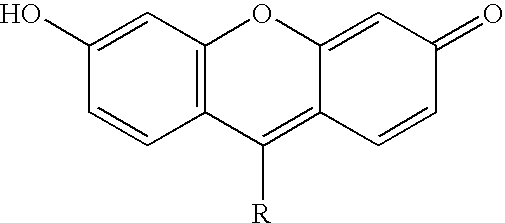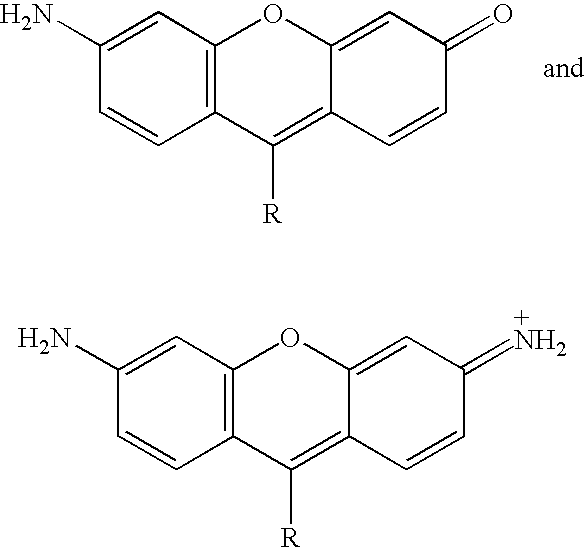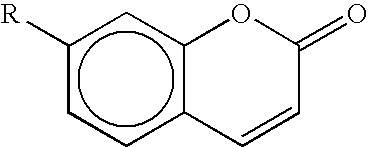Novel dyes for the detection or quantification of desirable target molecules
a target molecule and dye technology, applied in the field of dyes for the detection or quantification of desirable target molecules, can solve the problems of generating more complex structures, and achieve the effects of enhancing fluorescence, high affinity for binding, and increasing fluorescen
- Summary
- Abstract
- Description
- Claims
- Application Information
AI Technical Summary
Benefits of technology
Problems solved by technology
Method used
Image
Examples
example 1
Synthesis of Dye 101
(a) Preparation of 7-Formyl julolidine (Compound 1)
[0136] A solution of julolidine (15.0 g, 86.6 mmol) in DMF (100 ml) was cooled in an ice bath. While vigorously stirring this solution, POCl3 (20.0 g, 129.8 mmol) was added drop wise. After the addition of POCl3 was complete, the ice bath was removed and the reaction mixture was stirred at room temperature for 30 minutes. An aqueous solution of sodium acetate (25% w / w, 20 ml) was then added to the reaction mixture and it was heated in an oil bath (T=110° C.) for 10 min. The reaction mixture was cooled and poured into ca. 500 ml water and extracted with ethyl acetate. The organic layer was washed twice with water followed by brine, dried over sodium sulfate and then evaporated to dryness to yield 12.0 g of a light yellow solid (Compound 1) with the structure given below:
(b) Preparation of 2-methylbenzothiazole-6-sulfonyl chloride (Compound 2)
[0137] Chlorosulfonic acid (20 ml, 335.0 mmol) was cooled in an ic...
example 2
Synthesis of Dye 102
(a) Preparation of N-(6-carboxyl hexane)-2,3,4 tetrahydro quinoline (Compound 5)
[0141] A mixture of 1,2,3,4 tetrahydro quinoline (10.0 g, 75.0 mmol), 6-bromo-hexanoic acid (21.9 g, 112.5 mmol) and triethyl amine (11.4 g, 112.5 mmol) in 50 ml ethanol was refluxed for 16 hours. The reaction mixture was cooled and precipitated. The precipitate was then collected by filtration. The remaining solvents were removed in a rotary evaporator and to the residue thus obtained 200 ml ethyl acetate and 200 ml water was added. The organic layer was separated, washed with water and brine, dried over sodium sulfate and evaporated to dryness to yield 20.0 g of a dark brown oil (Compound 5) with the structure given below.
(b) Preparation of N-(6-carboxyl hexane)-2,3,4 tetrahydro-7-formyl quinoline (Compound 6)
[0142] This procedure was carried out as described previously in step (a) of Example 1, with POCl3 (4.7 g, 30.3 mmol) and DMF (40 ml) and using compound Compound 5 (5.0 ...
example 3
Synthesis of Dye 103
(a) Preparation of N-[N′-(4′-Sulfobutyl)-2-methylbenzothiazole-6-sulfonyl)piperidine, Inner Salt (Compound 7)
[0144] A mixture of Compound 3 (1.0 g, 3.4 mmol) (from step (c) of Example 1) and 1-4-butane sultone (0.55 g, 4.0 mmol) was heated in a pressure tube at 140-145° C. for 3 hours. The mixture was allowed to cool to room temperature, and the resulting mass was triturated with acetone (40 ml) until a pink solid separated. The solid was collected by centrifugation, washed with acetone and dried under vacuum to yield 0.21 g (14%) of Compound 7 with the structure:
(b) Preparation of Dye 103
[0145] A mixture of compound 7 (0.20 g, 0.46 mmol), 9-ethyl-3-carbazolecarboxaldehyde (0.11 g, 0.50 mmol) and piperidine (20 μL, 0.2 mmol) was refluxed in ethanol (2 ml) for 18 hours. The reaction mixture was cooled to room temperature and mixed with 20 ml ethyl acetate. The precipitated solid was collected by centrifugation, washed with ethyl acetate (2×25 ml) and dried ...
PUM
| Property | Measurement | Unit |
|---|---|---|
| wavelength | aaaaa | aaaaa |
| pH | aaaaa | aaaaa |
| temperature | aaaaa | aaaaa |
Abstract
Description
Claims
Application Information
 Login to View More
Login to View More - R&D
- Intellectual Property
- Life Sciences
- Materials
- Tech Scout
- Unparalleled Data Quality
- Higher Quality Content
- 60% Fewer Hallucinations
Browse by: Latest US Patents, China's latest patents, Technical Efficacy Thesaurus, Application Domain, Technology Topic, Popular Technical Reports.
© 2025 PatSnap. All rights reserved.Legal|Privacy policy|Modern Slavery Act Transparency Statement|Sitemap|About US| Contact US: help@patsnap.com



